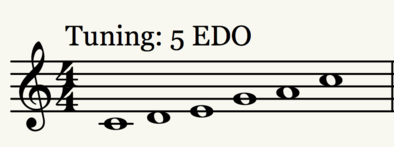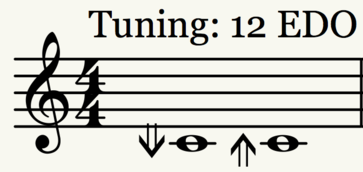Pain free guide to Sagittal
Sagittal is one of the best systems for microtonal notation. It allows virtually any tuning to be notated with ease and it's pretty easy to get the hang of if you're good with standard notation already. If you are not then this will not be much use to you as it only adds to the complexity that 12edo normally has.
Basics
Sagittal is basically a way to notate ANY tuning practically with regular old notation you learned since Miss Betty Jo sat you down to read your first music in piano lessons when you were little. Sagittal is a sort of extension of regular notation, but it's designed so that it can accommodate almost any tuning (at least, most practical tunings can be notated in it). “How does it do this?”, you may ask. Well, first of all, in sagittal, the normal lines and spaces that have no accidental signs (naturals) change depending on the tuning we are in. You see, normal notation works by a chain of seven fifths producing the scale natural notes or white keys on the piano: C D E F G A B C. This works well because of technical and historical reasons that are beyond the scope of this article–you can read about it more on Chain of fifths and 5L 2s. The point is, the chain of fifths is important. Chains of fifths make logical sense when building a notation system, and sagittal always corresponds the natural notes on the staff with the closest possible equivalent to a chain of fifths in the tuning.
It doesn't matter if the fifth in your tuning is really inaccurate, it still forms a chain corresponding to the naturals on the staff. 5edo (dividing the octave into 5 equal parts tuning) for example, has 3\5, a 720 cent interval, which is the closest possible interval to a fifth in 5edo. Therefore, the notes correspond to the chain of five fifths… "BUT WAIT A MINUTE! THAT MAKES NO SENSE, THERE HAVE TO BE SEVEN PITCHES!” Exactly, that's why with 5edo, we only need to use five of the pitches on the staff which end up LOOKING like this if we write out 5edo:
 To the left you can see that it corresponds to the normal pentatonic major scale (C D E G A C) that most people are familiar with in music.
To the left you can see that it corresponds to the normal pentatonic major scale (C D E G A C) that most people are familiar with in music.
This is because a chain of five fifths will inevitably form C G D A E. The weird thing here is that 5edo only has five notes, meaning that no matter how we order the scale, it's the same mode; there is only one 5 tone mode. However if we analyze a 5 tone score, we can see that different positions in the scale do indeed have a different effect in music, because we are moving lower or higher from the main tonic position. This is an example of how sagittal will allow us to really understand context of alternate tuned music.
7edo is exactly like the major scale about how it corresponds to the naturals on the staff, except that unlike 5edo, all the lines and spaces pitches are used. This means we can
assume that these pitches are tuned roughly to 7edo without the need of small accidental signs for the natural scale. However when we get to 9edo, something interesting happens…
9edo has well, more than seven pitches, and there are only seven pitches on the staff before it repeats. Sagittal doesn't allow to changes the staff, additional lines, or other things like that. So for 9edo, you construct a chain of seven fifths like intervals, the remaining two are notated by adding an accidental next to them. This is where things get a little tricky, but also cool.
Accidental markings
The point of sagittal is that it has alot of symbols designed to represent TINY pitch increments for any given tuning. It's cool in that it allows flexibility to suit a user's needs. If we wanna be abstract and just give the performer a general idea of what to do or write down ideas our self, we can do that. On the other hand if we want to be very VERY precise or notate something freakin insane like 72edo, then we can do that too, given that it's going to be way more tricky due to higher complexity. There are literally, multiple ways to notate the same tunings in sagittal and it all depends on the person. More on that in a minute ;)
Accidental markings in sagittal are not absolute, the same symbol in one tuning represents a different pitch alteration than other tuning. The idea here is sagittal is based on degrees in the scale not absolute pitch difference. For example, in 12edo, the ♯ sign represents a 100 cent difference BUT this sign could also be interpreted as a 1 degree of 12edo shift meaning potentially we can use it to indicate a one degree pitch difference in ANY TUNING!! But that doesn't really work when we have more to deal with. In 24edo we have quarter tones in addition to three quarter tones so how can we notate that?? We need more symbols and sagittal easily provides those.
What we have in sagittal is a tier system, accidentals that represent chromatic alterations of a given tuning. It starts large and gradually gets to finer and finer distinctions depending on how many notes you want to distinguish. The way it works is you have one accidental indicating a pitch difference of one degree and this is added on to the notes beginning where the seven fifths cycle ends. In other words if you have F C G D A E B when you get to F again, you need to use this +1 accidental. So in 12edo we use a ♯ sign like this F C G D A E B F♯ C♯ G♯ D♯ A♯… the cycle continues with E♯ but that is simply an enharmonic of the note F so it's no different in 12edo. We use a ♯ sign indicating a +1 or ♭ indicating −1, sagittal uses different signs for 12edo's +1 and −1 which look like this:
 We can see that these symbols look a bit different from normal sharps and flats. But they are the exact same thing, because they both represent a +1 and -1 alteration in 12edo. This means that any edo with only one size of alteration will use these signs here to indicate it. Alternatively, if you're someone who prefers to use sharps (♯) and flats (♭) you can use that too, as long as you indicate the edo it represents. Sagittal must have the edo indicated or it will not make sense what tuning you are trying to convey. So if you use these arrows for 12edo for some reason, you have to say it's for 12edo.
We can see that these symbols look a bit different from normal sharps and flats. But they are the exact same thing, because they both represent a +1 and -1 alteration in 12edo. This means that any edo with only one size of alteration will use these signs here to indicate it. Alternatively, if you're someone who prefers to use sharps (♯) and flats (♭) you can use that too, as long as you indicate the edo it represents. Sagittal must have the edo indicated or it will not make sense what tuning you are trying to convey. So if you use these arrows for 12edo for some reason, you have to say it's for 12edo.
Now if we wanna write this symbol as in text without a special font, we use the ascii version: /||\ which kinda looks like the symbol, so that shouldn't be hard to remember. The symbols on the left would appear as C\||/ and C/||\ in text. The symbols on the left are read the same as # and b as "Sharp" and "Flat".
Back to 9edo
9edo then can be notated with the same +1 −1 accidental but unlike 12edo, there is only nine pitches meaning the chain of fifths ends at C/||\ or C♯ if you prefer. Thus we build a chain of F C G D A E B F/||\ C/||\. Unlike 12edo, 9edo doesn't contain a complete cycle of fifths in that going nine fifths doesn't lead you back to the note you started on but rather just kinda stops leaving a diminished like fifth in it's place when moving beyond it. There is no 720 cent fifth from C/||\ but rather some form of augmented fourth or diminished sixth. What I'm trying to say is that it's an ET so OF COURSE there is a fifth from every place but it won't appear on paper like that so we just consider the chain's stopping point at C/||\.
The full 9edo appears as:
You'll notice that the scale left on the naturals becomes 2 1 1 2 1 1 1 or the mavila scale of 9edo which is awesome and sensible because you can play in mavila 7- in 9edo and write it all out in all nine keys logically. Why? Because if you go by this circle of fifths logic here, AND you can notate a scale using the natural notes, it's going to work really well for notating it in all keys.
We'll talk more about key signatures a little later!
10edo and 11edo
10edo and 11edo work in basically the same exact way. You use the /||\ and \||/ signs to indicate shifts of +1 and −1 degrees in the scales.

